For years growing up, I remember Vietnamese Lunar New Year (Tết) always involved big gatherings, visits to the temple, and a lot of really, really good food.
Once my brothers and I became adults though, my parents changed their New Year traditions and started flying down to San Jose to ring in Tết with their friends. San Jose, if you don’t know, well because why would you lol, is home to the largest number of Vietnamese people in any city outside of Vietnam itself, which makes it a popular North American spot to converge for Lunar New Year celebrations.
It’s something my parents would look forward to each year. Of course, we’d still have celebrate here at home with a smaller Lunar New Year family dinner, and occasionally one of us siblings would go with our parents to a local Tết party put on by the Edmonton Vietnamese Association, but it was never quite like the Tết parties we’d hold at home, or attend at family friends’ homes, as kids.
This year especially (2021, pandemic Year 2), will be unlike any other Tết before it. There will be no new years celebrations in San Jose (my parents are really bummed about that), nor will there be in-person new years celebrations here in Edmonton.
As I get older and learn more about my Vietnamese culture and heritage, pull recipes from my mom (lol), and catalogue it on this blog—reconnecting with the Tết we used to have was top of my mind this 2021.
So that’s what this post is about!
After consulting with my mom, and doing a little Internet research (I don’t know if Google gets enough credit for helping people learn and understand their cultures a little bit more lol. It usually gives me correct prompts to ask my parents / things that may not be top of mind for them when I ask questions and suddenly they’ve got lots to talk about if I tell them I read about some Vietnamese thing online lol):
I’ve put together a little celebration guide for the Vietnamese Lunar New Year, including traditional foods commonly found in our home each Tết, how to play a popular Vietnamese gambling game even us kids got to partake in growing up (much lower stakes than the adults lol), some New Year’s Greetings and well wishes we seem to only say once a year before receiving red envelope gifts, and an audio clip of my parents sharing some of their New Year’s memories growing up in Vietnam.
It was fun learning more about this part of my Vietnamese culture and heritage. And honestly I’m excited to have a permanent resource specific to how my family celebrates, to help guide my own future Vietnamese Lunar New Year parties (especially when it’s safe to have parties again!)
I hope this helps you as well! And even if you don’t celebrate Lunar New Year, I hope you enjoy learning about Vietnamese Lunar New Year customs!

Vietnamese Food We Eat for Tết (Lunar New Year)
Like any celebration, the food plays a very key role. A traditional Vietnamese Tết meal involves some dishes we have throughout the year (comfort food year-round!), but also some special items just for the New Year.
Here are Vietnamese dishes you’d typically find during our New Year’s spreads. Some of these I recreated (and got help from my mom to recreate) for this blog post. I also list some other Vietnamese New Year’s Food resources at the end of the section if you’d like to dive in even deeper!
Traditional Vietnamese Tết Foods
- Thịt kho (pork belly and eggs)
- Củ kiệu (pickled leeks)
- Cà pháo (pickled eggplants)
- Dưa cải chua (pickled mustard greens)
- Chả lụa (Vietnamese ham)
- Bánh chưng (Square sticky rice mung bean cake)
- Bánh tét (Round sticky rice mung bean cake)
- Bánh tráng (Rice paper roll with thịt kho)
- Nem chua (Fermented sour pork)
- Canh khổ qua (Stuffed bitter melon soup)
- Mứt gừng or dua (Candied ginger or coconut)
- Various Seeds & Nuts like Hạt dưa (Watermelon), Hạt bí (Pumpkin), Hạt hướng dương (Sunflower), Hạt điều (Cashew) or Hạt dẻ cười (Pistachio)
I chose some of the traditional Vietnamese Tết foods from this list to recreate at home—and also picked up some items from the Asian grocers because why make things hard? lol

In my Vietnamese Tết Lunar New Year food spread, you’ll see pickled egg plants, leeks, and mustard greens, Vietnamese ham, pork belly and eggs, sticky rice and mung bean cakes, rice and canh chua (a sweet and sour Vietnamese soup—I had actually asked my mom if she could contribute to my blog post by making the more traditional new years stuffed bitter melon soup but she said she was lazy and defaulted to canh chua instead lol—whatever). My dad also ordered the banh chung (sticky rice and mung bean cakes) and gifted that to me.
There are some more labour intensive Tết dishes and less labour intensive Tết dishes, like thit kho (pork belly and eggs) is pretty simple to make, but my parents would much rather buy banh chungs or nem chua (fermented sour pork) than make them so they’ve sort of passed on that thinking to me too (lol—one day, likely for the purposes of this blog and continued reconnection to my culture and heritage, I’ll make those “harder” dishes but also, why stress when you can buy them pre-made? lol)
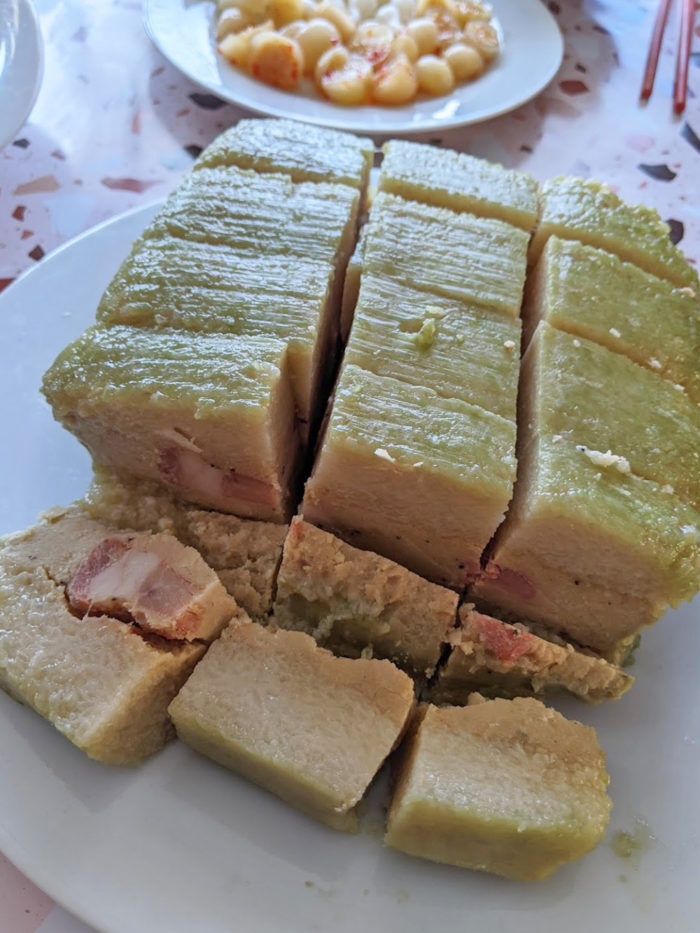
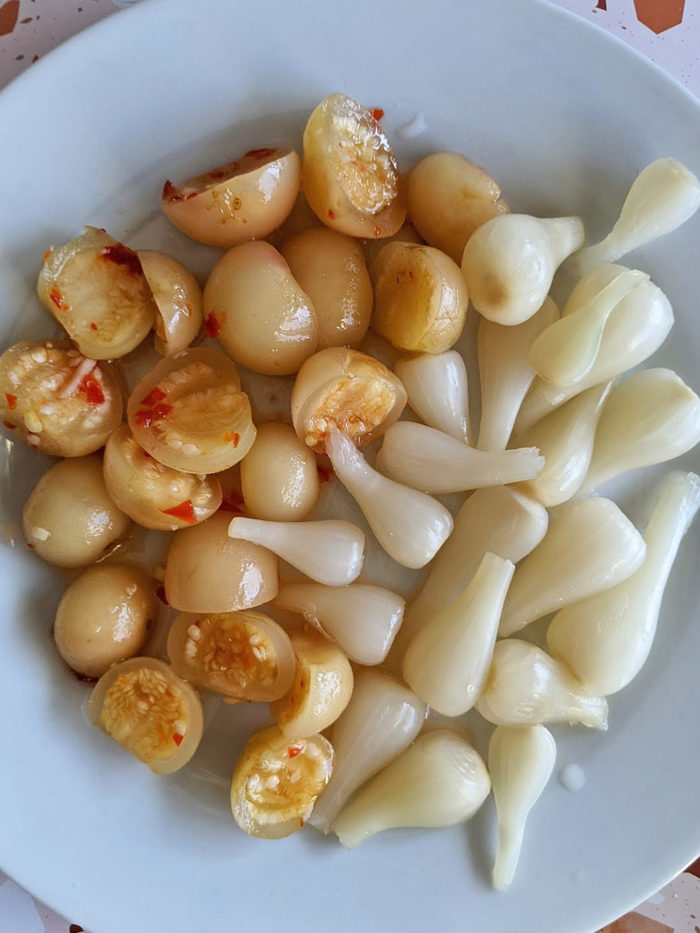

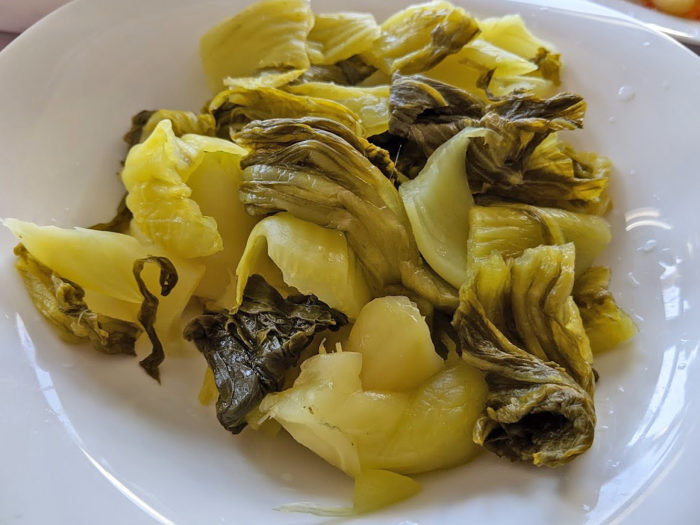
Generally when cooking Vietnamese Tết dishes, you cook with leftovers in mind, which is why any kind of braised meat works because it reheats really well.
Most Vietnamese meals, whether for the New Year or not, will typically have a main meat dish, pickled vegetables, rice, and a canh (soup) of some kind, so you certainly expect the same for New Year meals.
I absolutely love cooking (and eating!!!) Vietnamese food and also asking my parents all sorts of questions about Vietnamese food, culture, traditions. I asked my parents *a lot* of questions about Tết this year, and it’s been a lot of fun learning from them (and of course, making and eating the food). I think my parents have really been enjoying sharing customs with me too.
So that sort of covers the food aspect of Tết!!
Here’s a few other Vietnamese New Year food resources if you’re interested:
- 20+ Traditional Food for Vietnamese New Years (vina.com)
- Essential Vietnamese New Year Foods (citypassguide.com)
- Essential Foods for Tet holidays (vietnamonline.com)
I’ll blog about how to make Thịt kho (the pork and eggs dish) separately! Stay tuned.

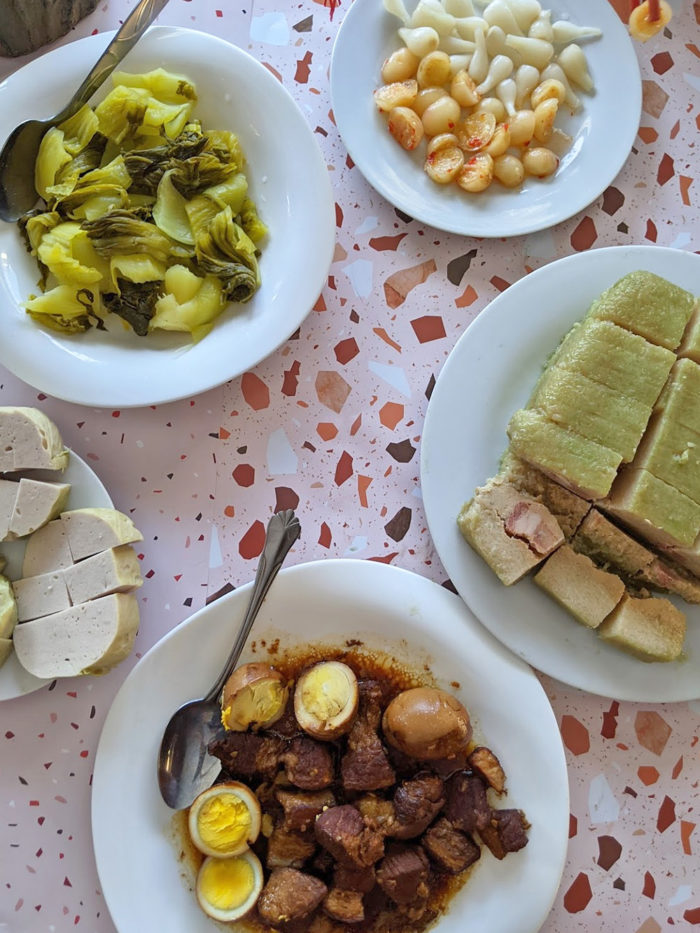
Now moving onto the games part of Tết!
Bầu Cua Cá Cọp: Vietnamese New Year Gambling Game

Last Lunar New Year, a vague memory of me playing a Vietnamese game with my siblings came to my mind and I remember asking my mom, ‘what was that game we used to play during new years… there was a lot of yelling and I think betting money?’
She was quick to tell me that gambling game was called “Bầu Cua Cá Cọp”—a popular gambling game played by people of all ages during Vietnamese Tết (Lunar New Year).
The game is really simple. There is a game board separated into six boxes featuring different illustrations. There are three dice and each dice has the same illustrations depicted on the game board. You place money (your bet!) on which illustration you think the dice will reveal and depending on how many of your bet symbols are shown on the rolled dice, you win money.
f one die matches with a bet, the person who placed the bet wins the same amount as their bet. If two dice matches with a bet, the person who placed the bet gets two times their money. If three dice matches with a bet, the person who placed the bet wins three times their money (three dice is pretty rare though lol). If no symbols match up to bets (or some bets don’t match up to symbols), that money goes to the dealer. Easy, fun, and when the dealer is rolling the dice, highly recommend you yell “Bầu Cua Cá Cọp” to add to the anticipation and atmosphere.
There’s also a Chinese version called Hoo Hey How that is essentially identical to the Viet game.
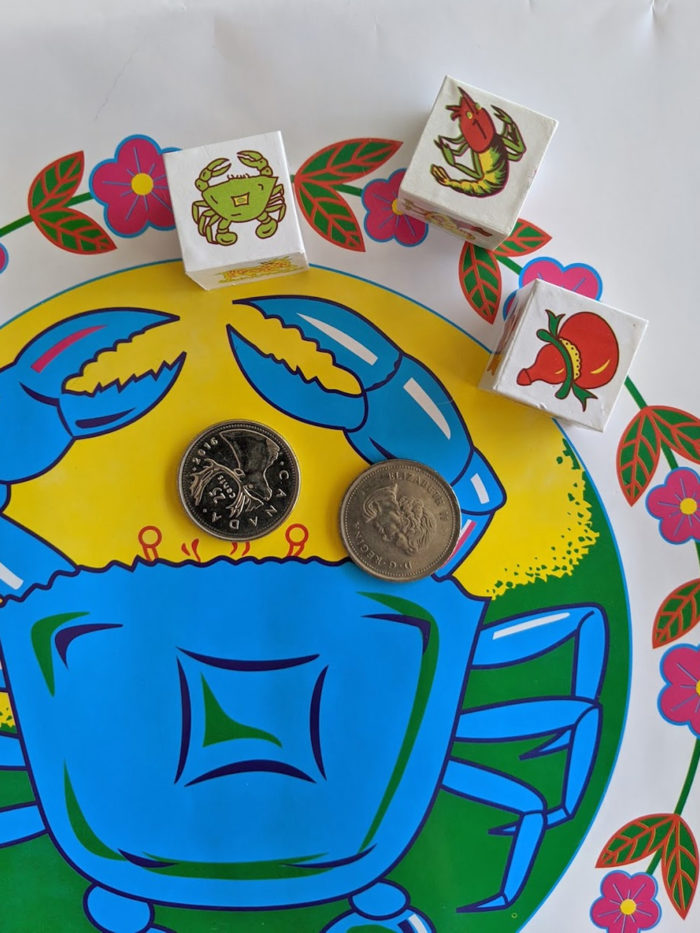

Watch the Bầu Cua Cá Cọp TikTok video I made:
@lindorable AsianTok, do you remember playing this ##LunarNewYear gambling game? ✨💰
Don’t Forget The Red Envelopes and New Year’s Greetings
Vietnamese New Year’s Greetings go a little something like this:
- “Chúc mừng năm mới” (Happy New Year)
- “An khang thịnh vượng” (I hope there are no problems in your life)
- “Vạn sự như ý” (I hope whatever you want you get)
- Luôn luôn khỏe mạnh” (I wish you lots of health)
- Dồi dào sức khỏe (I hope you are always healthy)
You can share New Years greetings to anyone but often these greeting are shared by younger Vietnamese family members to older Vietnamese family members as the phrases to sort of unlock their New Year’s money (“Li Xi” which means lucky money and has roots tied to Chinese traditions).
You share your greeting and elder Vietnamese are to give you your lucky money in red envelopes. We learned after we got married that once you’re married, you don’t really get Li Xi anymore, lol. One of my brothers had told me at some point growing up that we should save some of the cash in the red envelope and the longer you save it the luckier it will be when you spend it, but I feel like they might’ve made that up.
In terms of how much money goes in the envelope, we’ve been giving $10 and $20 bills for our young niece and nephew. As you get older, typically your parents will scale up how much they stuff in your envelope (I do recall my brothers getting $100 bills at one point in their lives… lol) and as adults even though my parents don’t give us red envelope money anymore, sometimes they’ll stuff a lottery ticket inside a red envelope just to give you something. I’ve been to events where the red envelopes have cards and chocolate inside too.
But like any kind of gift, I like to say it’s not about the money or how much money is in the envelope, it’s more about the New Year’s greetings and lucky gesture (wishing you good luck).
Watch the Vietnamese Lunar New Year Greetings video I made:
I also made a video sharing some Vietnamese #Tet phrases!
— Linda Hoang 💕 (@lindork) February 9, 2021
Also thanks @Twitter for making #Tet a cute emojified hashtag. 🥺❤️ #LunarNewYear #LNY2021 pic.twitter.com/WWfDMydjxI

—
So that’s just a bit of A Celebration Guide to Vietnamese Tết (Lunar New Year), based on my family’s traditions. As a bonus (but really only if you can understand Vietnamese LOL), I’ve embedded an audio clip of my mom and dad sharing some memories of how they celebrated Tết back in Vietnam.
I didn’t know when I was recording it that I would share it on my blog so excuse the not-the-best sound!
Some translation for what my parents shared about Tết in Vietnam:
A lot of the food pictured in this blog post is what they would eat for New Years. My dad also always got a new shirt, my mom would love visiting the market to see all the flowers on display, and they’d both like going to the movies and playing Bầu Cua Cá Cọp. Women would wear their best Vietnamese Áo dài (long, traditional dresses) during this time as well.
Part of the Lunar New Year included inviting relatives who have already passed to join your dinner table and enjoy the festivities (as a kid, I remember jokingly sitting in empty seats that apparently were being sat on by my dead family members, and thinking that was a hilarious joke, lol).
Leading up to Tết is also when Vietnamese households would choose to do entire cleanings of their homes (like Western ‘spring cleaning’ but for New Years), paint the walls, wash their blankets and bed sheets. And there would be a ton of fireworks and firecrackers set off throughout Tết.
This was all before the 1975 Fall of Saigon though. Tết after the North Vietnam communists won was never quite the same (at least for my parents, until they fled the country ten years later in 1985).
Not to end on a bummer note though, lol.
Learn more about Vietnamese Tết celebrations and its history:
I look forward to when the pandemic is over, air travel is safe again, and I can fly to San Jose with my parents to take in the Vietnamese Tết Lunar New Year celebrations there!
Linda
- Follow @lindork on Twitter
- Follow @lindork on Instagram
- Like Lindork – Linda Hoang on Facebook
- Follow Linda on TikTok (@lindorable)
If you’re Edmonton area and want hyperlocal recommendations on what to do, eat, and things to know each week, plus subscriber-only giveaways, subscribe to my weekly newsletter!



2 Comments
Happy Lunar New Year to you and may your interesting posts continue along.
What a wonderful post celebrating Vietnamese Tết traditions! I can totally relate to the joy of big gatherings, temple visits, and the amazing food during Lunar New Year. It’s heartwarming to hear how your parents adapted their traditions to celebrate Tết in San Jose with their friends. Embracing new experiences while preserving cultural roots is what makes this celebration so special. Have you discovered any unique food or game traditions during your visits to San Jose for Tết? Feel free to share, and happy Lunar New Year!